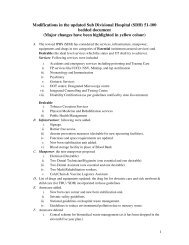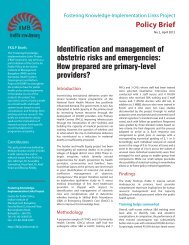Modifications in the updated Sub Divisional Hospital (SDH) 31 ... - IIMB
Modifications in the updated Sub Divisional Hospital (SDH) 31 ... - IIMB
Modifications in the updated Sub Divisional Hospital (SDH) 31 ... - IIMB
You also want an ePaper? Increase the reach of your titles
YUMPU automatically turns print PDFs into web optimized ePapers that Google loves.
Seismic Safety Guidel<strong>in</strong>es<br />
Seismic safety of non-structural elements <strong>in</strong> <strong>Hospital</strong>s/Health facility.<br />
Annexure VI<br />
• Health Facility/<strong>Hospital</strong> should rema<strong>in</strong> <strong>in</strong>tact and functional after an<br />
earthquake to carry on rout<strong>in</strong>e and emergency medical care.<br />
• There may be <strong>in</strong>creased demand for its services after an earthquake.<br />
• <strong>Hospital</strong> accommodates large number of patients who cannot be evacuated <strong>in</strong><br />
<strong>the</strong> event of earthquake.<br />
• <strong>Hospital</strong>s have complex network of equipment specialised furniture, duct<strong>in</strong>g,<br />
wir<strong>in</strong>g, electrical, mechanical fitt<strong>in</strong>gs which are vulnerable due to earthquake.<br />
• The Non-structural element may value very high from 80% to 90% <strong>in</strong>case of<br />
<strong>Hospital</strong> unlike office build<strong>in</strong>gs due to specialized medical equipments.<br />
• Even if build<strong>in</strong>g rema<strong>in</strong>s <strong>in</strong>tact, it may be rendered non-functional due to<br />
damage to equipments, pipel<strong>in</strong>es, fall of partitions and store material, etc.<br />
• While <strong>the</strong> safety of build<strong>in</strong>g structure is <strong>the</strong> duty of PWD and designers of <strong>the</strong><br />
build<strong>in</strong>g, <strong>the</strong> risk of non-structural component has to be dealt by staff and<br />
authorities of <strong>the</strong> health facility.<br />
• This non-structural Mitigation & reduction of risk can be achieved through<br />
series of steps:<br />
i) Sensitization (understand<strong>in</strong>g earthquakes and safety requirements)<br />
ii) Earthquake Hazard Identification <strong>in</strong> <strong>the</strong> hospital<br />
iii) Hazard survey and prioritization.<br />
iv) Reduc<strong>in</strong>g non-structural hazards.<br />
Step I : Understand<strong>in</strong>g Earthquakes and Safety requirements<br />
• Awareness and sensitization about safety<br />
• The structural elements of a build<strong>in</strong>g carry <strong>the</strong> weight of <strong>the</strong> build<strong>in</strong>g like<br />
columns, beams, slabs, walls, etc.<br />
• The Non-structural elements do not carry weight of <strong>the</strong> build<strong>in</strong>g, but <strong>in</strong>clude<br />
w<strong>in</strong>dows, doors, stairs, partition and <strong>the</strong> build<strong>in</strong>g contents: furniture, water tank,<br />
hospital equipment, medical equipment, pharmacy items and basic <strong>in</strong>stallation<br />
like water tanks, medical gases, pipel<strong>in</strong>es, air condition<strong>in</strong>g, telecommunications,<br />
electricity etc.<br />
Step II : Earthquakes hazard identification <strong>in</strong> <strong>the</strong> hospital<br />
• Tall, narrow furniture like cupboards can fall on people, block doors/<br />
passages/exits<br />
• Items on wheels or smooth surfaces can roll and crash<br />
• Large and small th<strong>in</strong>gs on shelves, etc. can knock, fall, crash and damage<br />
severely.<br />
103




